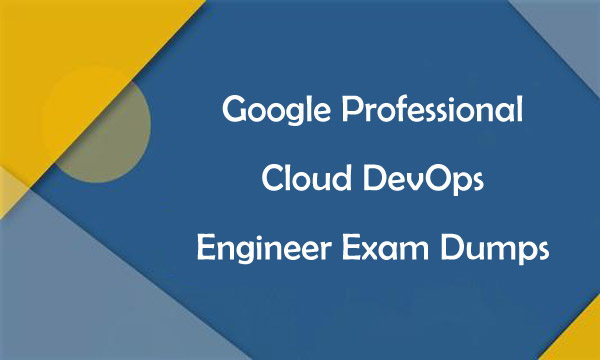Google Professional Cloud DevOps Engineer Exam Dumps
March 12,2021 01:24 AM
Professional Cloud DevOps Engineer exam is a hot one of Google certification tests. A Professional Cloud DevOps Engineer is responsible for efficient development operations that can balance service reliability and delivery speed. After you pass Google Professional Cloud DevOps Engineer exam, you are skilled at using Google Cloud Platform to build software delivery pipelines, deploy and monitor services, and manage and learn from incidents. To prepare this Google Professional Cloud DevOps Engineer exam, the related information is helpful for you to prepare the test.

Google Professional Cloud DevOps Engineer Exam
Length: Two hours
Registration fee: $200
Language: English
Exam format: Multiple choice and multiple select
Recommended experience: Three+ years of industry experience including one+ years managing solutions on GCP.
Exam Delivery Method:
Take the online-proctored exam from a remote location.
Take the onsite-proctored exam at a testing center.
Professional Cloud DevOps Engineer Exam Topics
Google Professional Cloud DevOps Engineer exam topics cover the following sections.
Apply site reliability engineering principles to a service
Optimize service performance
Implement service monitoring strategies
Build and implement CI/CD pipelines for a service
Manage service incidents
Practice Professional Cloud DevOps Engineer Exam Dumps
Google Professional Cloud DevOps Engineer exam dumps questions can help you test all the above topics. Share some Google Professional Cloud DevOps Engineer exam dumps questions below.
1.Your company follows Site Reliability Engineering principles. You are writing a postmortem for an incident, triggered by a software change, that severely affected users. You want to prevent severe incidents from happening in the future.What should you do?
A. Identify engineers responsible for the incident and escalate to their senior management.
B. Ensure that test cases that catch errors of this type are run successfully before new software releases.
C. Follow up with the employees who reviewed the changes and prescribe practices they should follow in the future.
D. Design a policy that will require on-call teams to immediately call engineers and management to discuss a plan of action if an incident occurs.
Answer: B
2.You are running an application in a virtual machine (VM) using a custom Debian image. The image has the Stackdriver Logging agent installed. The VM has the cloud-platform scope. The application is logging information via syslog. You want to use Stackdriver Logging in the Google Cloud Platform Console to visualize the logs. You notice that syslog is not showing up in the "All logs" dropdown list of the Logs Viewer.What is the first thing you should do?
A. Look for the agent's test log entry in the Logs Viewer.
B. Install the most recent version of the Stackdriver agent.
C. Verify the VM service account access scope includes the monitoring.write scope.
D. SSH to the VM and execute the following commands on your VM: ps ax I grep fluentd
Answer: D
3.Your company follows Site Reliability Engineering practices. You are the Incident Commander for a new. customer-impacting incident. You need to immediately assign two incident management roles to assist you in an effective incident response. What roles should you assign? Choose 2 answers
A. Operations Lead
B. Engineering Lead
C. Communications Lead
D. Customer Impact Assessor
E. External Customer Communications Lead
Answer: A,D
4.You support the backend of a mobile phone game that runs on a Google Kubernetes Engine (GKE) cluster. The application is serving HTTP requests from users. You need to implement a solution that will reduce the network cost. What should you do?
A. Configure the VPC as a Shared VPC Host project.
B. Configure your network services on the Standard Tier.
C. Configure your Kubernetes cluster as a Private Cluster.
D. Configure a Google Cloud HTTP Load Balancer as Ingress.
Answer: A
5.You support a production service that runs on a single Compute Engine instance. You regularly need to spend time on recreating the service by deleting the crashing instance and creating a new instance based on the relevant image. You want to reduce the time spent performing manual operations while following Site Reliability Engineering principles.What should you do?
A. File a bug with the development team so they can find the rootcause of the crashing instance.
B. Create a Managed Instance Group with a single instance and use health checks to determine the system status.
C. Add a Load Balancer in front of the Compute Engine instance and use health checks to determine the system status.
D. Create a Stackdriver Monitoring dashboard with SMS alerts to be able to start recreating the crashed instance promptly after it has crashed.
Answer: C
Professional Cloud DevOps Engineer Exam Dumps PDF & SOFT | 1 Year Free Update | Money Back Guarantee
- Related Suggestion
- Google Professional Cloud Database Engineer Exam Dumps August 27,2022
- Professional Google Workspace Administrator Certification Exam Dumps August 11,2022
- Google Professional Cloud Security Engineer Exam Updated Dumps May 28,2021
- Google Professional Machine Learning Engineer Dumps Questions March 16,2021
- Google Associate Android Developer Exam Dumps February 02,2021

